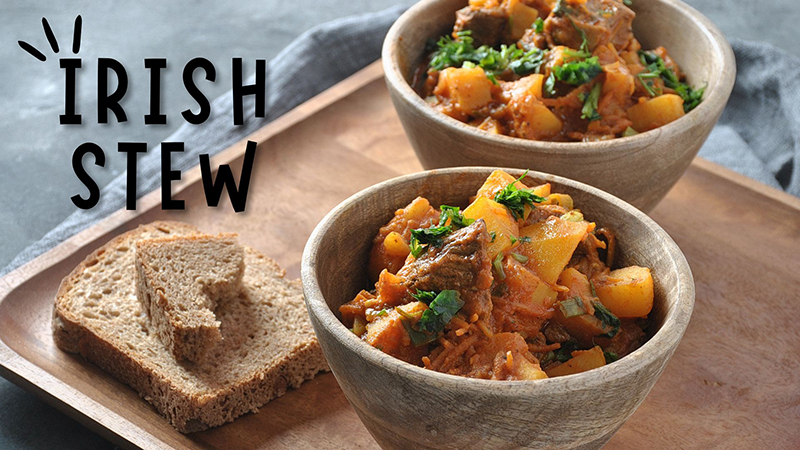Irish stew has become synonymous with Irish cuisine. Its rich history dates back to the early 19th century when it was a simple meal made by poor families who used whatever ingredients they had available. Today, it is a celebrated dish that is enjoyed by people all over the world.
The History of Irish Stew
The exact origins of Irish stew are somewhat shrouded in mystery, but it is believed to have originated in the 19th century. At that time, the dish was often made by shepherds and rural farmers who had access to only a few ingredients but needed a nourishing meal to sustain them through long days of work. The dish was traditionally made with lamb or mutton, potatoes, onions, water, and was slow-cooked in a pot over an open fire.
During the 19th century, Irish stew became a staple dish for many poor families in Ireland, as it was an affordable and filling meal that could be made with simple ingredients. The dish evolved over time to include other root vegetables such as carrots and turnips, and some families even added barley to the stew to help make it more filling.
The Ingredients of Traditional Irish Stew
Traditional Irish stew is made with a few simple ingredients that come together to create a delicious and wholesome meal. The basic ingredients include lamb or mutton, potatoes, onions, and water. Some variations of the dish also include carrots, turnips, and barley but this would be down to personal preference.
Lamb or mutton is the traditional meat used in Irish stew, as it was the most readily available to the people of the time. The meat is typically cut into small pieces and browned before use, potatoes after being peeled and sliced in to chunks are added to the stew to add substance and to help thicken the broth, finally onions are added to the pot for flavour

The Health Benefits of Irish Stew
Irish stew is a hearty and nourishing meal that offers a range of health benefits. The dish is high in protein, which is essential for building and repairing muscle tissue. It is also a good source of vitamins and minerals, including iron, zinc, and vitamin B12.
The potatoes in Irish stew are a good source of complex carbohydrates, which provide a slow release of energy and help to keep you feeling full for longer. The dish is also low in fat, making a perfect menu addition for anyone looking to eat more healthy.
In conclusion, Irish stew is a delicious dish that offers a range of health benefits. Whether you are looking for a comforting meal on a cold winter’s day or a nourishing feast after a long day at work, Irish stew is a dish that is sure to have you covered.
Regional Variations of Irish Stew
Irish stew is a national dish of Ireland, but did you know that there are regional variations of this hearty meal? Each region has its own unique take on the classic stew, with different ingredients and cooking methods. Below we’ll explore the different styles of Irish stew by region and the unique ingredients that go in to making them special.
The Different Styles of Irish Stew by Region
Dublin Coddle
Dublin coddle is a stew that originated in Dublin. It’s made with sausages, bacon, onions, and potatoes, and is often seasoned with parsley and thyme. The stew is slow-cooked for several hours, allowing the flavours to blend together and create a rich, savoury dish.
Connemara Stew
Connemara stew is a traditional Irish stew that hails from the Connemara region of County Galway. It’s made with lamb or mutton, potatoes, onions, and carrots, and is often flavoured with thyme and bay leaves. The stew is slow-cooked for several hours, resulting in tender, melt-in-your-mouth meat and vegetables.
Ulster Stew
Ulster stew is a stew that’s popular in Northern Ireland. It’s made with beef or lamb, potatoes, onions, and carrots, while its often flavoured with parsley and thyme. like the rest stew is slow-cooked for several hours, resulting in a rich, savoury dish that’s perfect for cold winter nights.
The Unique Ingredients of Regional Irish Stews
Boxty
Boxty is a type of Irish potato pancake that’s often used in Irish stews. It’s made with grated potatoes, flour, and buttermilk, and is a staple of Irish cuisine. Boxty adds a unique texture and flavour to Irish stews, making them even more delicious and satisfying.
Guinness
Guinness is a dark, rich beer that’s brewed in Ireland. It’s often used as a flavouring agent in Irish stews, adding a deep, complex flavour to the dish and can be found in many pub served stews of today.
Irish Soda Bread
Irish soda bread is a type of bread that’s made with baking soda instead of yeast and has been very much part of the Irish food table for years and is often served with Irish stews. The bread gives added wholesome, element to the meal, and is perfect for soaking up the rich, savoury broth.
In conclusion, Irish stew is a delicious and comforting meal that has been enjoyed by generations of Irish people. Each region has its own unique take on the classic stew, with different ingredients and cooking methods. Whether you prefer Dublin coddle, Connemara stew, or Ulster stew, there’s a regional variation of Irish stew that’s sure to satisfy your taste buds.
How to Cook Traditional Irish Stew
If you’re looking to make a hearty and comforting meal, traditional Irish stew is the perfect choice. With a few simple ingredients and some classic cooking techniques, you can create a delicious and satisfying dish that’s perfect for any occasion. Here are some tips for making the perfect Irish stew:
The Best Cooking Techniques for Irish Stew
When it comes to cooking Irish stew, there are a few key techniques to keep in mind. First, you’ll want to brown the meat before adding any other ingredients. This helps to develop a rich, deep flavour that will infuse the entire dish. You can use lamb, mutton, or beef for your stew, depending on your personal preference.
Next, you’ll want to sauté some onions add garlic and place in a large pot or Dutch oven with some water. This will add flavour and depth to the dish, while helping to create a rich, savoury base. Once the onions are soft and translucent, you can add the meat back in, along with some potatoes, carrots, and other vegetables of your choice.
Finally, you’ll want to simmer the stew for a few hours, until the meat is tender and the vegetables are soft and flavourful. This will help to blend all the flavours together and create a delicious, comforting and cost efficient dish that’s perfect for a anytime.
Tips for Perfecting Your Irish Stew Recipe
If you want to take your Irish stew to the next level, there are a few tips and tricks you can use to make it even better. Here are some ideas to get you started:
- Use a good quality stock or broth to add depth and richness to the dish.
- Add some Guinness or other dark beer to the stew for an extra layer of flavour.
- Experiment with different herbs and spices to find the perfect combination for your taste buds.
- Serve the stew with some crusty bread or mashed potatoes for a truly comforting meal.
With these tips and techniques, you’ll be able to create a delicious and satisfying traditional Irish stew that’s sure to become a family favourite. So why not give it a try today?
Modern Twists on Irish Stew
Irish stew has been a beloved dish for centuries, but that doesn’t mean it can’t be updated with modern twists. Here are some creative variations of Irish stew that we love:
Creative Variations of Irish Stew
- Seafood Irish Stew: Swap out the traditional lamb or mutton for seafood like prawns, mussels, and white fish. Add some saffron and fennel to give it a Mediterranean twist.
- Vegetarian Irish Stew: Use vegetable broth and add a variety of root vegetables like parsnips, turnips, and sweet potatoes. You can also add some lentils or chickpeas for extra protein.
- Guinness Irish Stew: Add a pint of Guinness to the stew for a rich, malty flavour. This is a great option for those who love the taste of the iconic Irish beer.
Innovative Ways to Serve Irish Stew
- Irish Stew Pie: Top the stew with a layer of puff pastry and bake until golden brown. This is a great way to turn leftover stew into a new meal.
- Irish Stew Nachos: Layer crispy tortilla chips with shredded cheese and leftover stew. Top with sour cream, guacamole, and salsa for a fun twist on traditional nachos.
- Irish Stew Soup: Blend the stew until smooth and add some cream for a hearty soup. Serve with crusty bread for a delicious lunch or dinner.
These modern twists on Irish stew are a great way to experiment with the classic dish and make it your own. Whether you’re a meat lover or a vegetarian, there’s a variation of Irish stew that’s perfect for you.
Conclusion
Hopefully, i have given you some insight in to the history behind Ireland’s beloved stew. From its humble beginnings as a peasant dish made with simple ingredients like mutton, potatoes, and onions, to its modern-day variations with added vegetables and herbs, Irish stew has remained a staple part of Irish cuisine generations.
So the next time you sit down to enjoy a warm bowl of Irish stew, take a moment to appreciate the rich history and tradition behind this loved dish. It is a testament to the resilience and resourcefulness of the Irish people, and a reminder of the importance of simple, wholesome food in our lives.

Martina has been writing travel blogs since 2004, having spent all her life living in Ireland she has travelled the length and breath of the emerald Isle and still to this day finds some new to see and do.

